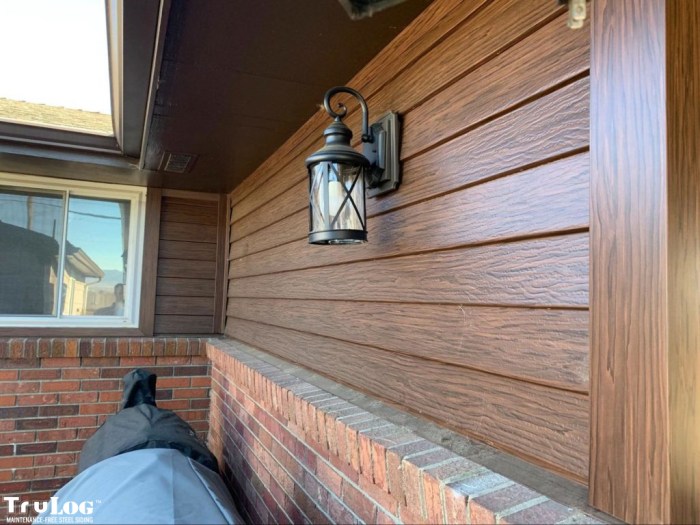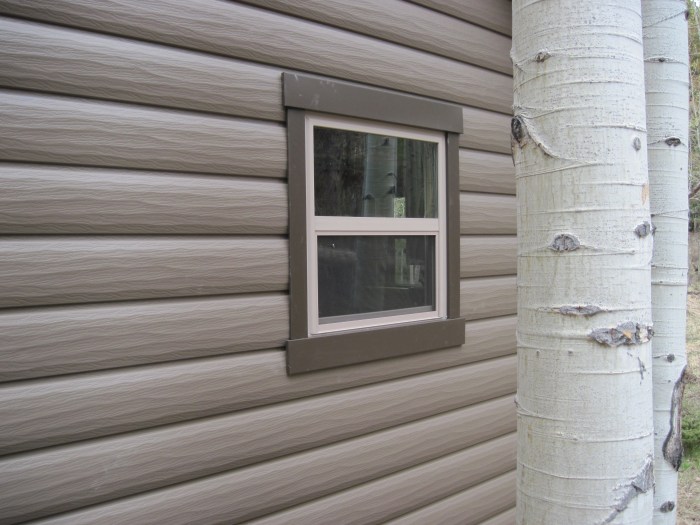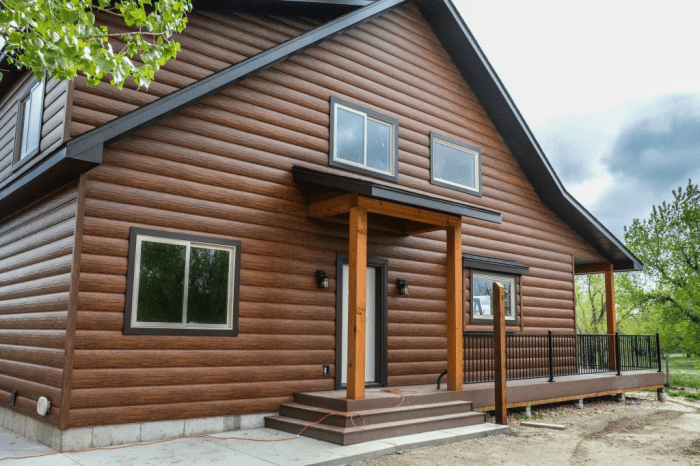TruLog siding offers a compelling alternative to traditional siding materials, promising a blend of durability, aesthetic appeal, and environmental consciousness. This guide delves into the multifaceted world of TruLog siding, exploring its composition, installation, maintenance, design versatility, cost-effectiveness, and environmental impact. From understanding its unique material properties to weighing its long-term value proposition, we aim to equip you with the knowledge needed to make an informed decision about incorporating TruLog siding into your next project.
We’ll cover everything from the manufacturing process and installation techniques to the various styles and finishes available, along with a detailed comparison to other popular siding options. We’ll also address common concerns regarding cost, maintenance, and environmental considerations, providing a balanced perspective to help you assess the suitability of TruLog siding for your specific needs and preferences.
TruLog Siding

TruLog siding offers a realistic log cabin aesthetic without the high maintenance and cost associated with real wood. This engineered product provides a durable and attractive exterior cladding option for homeowners seeking a rustic charm. Understanding its composition, manufacturing process, and performance characteristics is crucial for making informed decisions regarding its suitability for a specific project.
TruLog Siding Composition and Manufacturing
TruLog siding is a composite material, combining high-density polyethylene (HDPE) with wood fibers or other fillers. HDPE is a thermoplastic polymer known for its strength, flexibility, and resistance to weathering. The wood fibers add to the product’s structural integrity and contribute to its realistic wood-like texture. The exact proportions of HDPE and wood fibers may vary depending on the manufacturer and specific product line. The manufacturing process involves several key steps: first, the raw materials are mixed and melted. Then, this mixture is extruded into long profiles that mimic the shape and texture of real logs. Finally, these profiles are cut to the desired lengths, and potentially undergo additional finishing processes such as coloring and texturing to achieve a specific aesthetic. The result is a product that closely replicates the appearance of natural logs, but with enhanced durability and reduced maintenance requirements.
TruLog Siding Durability Compared to Other Siding Materials
The durability of TruLog siding compares favorably to other popular siding options. Its resistance to rot, insect infestation, and moisture damage surpasses that of natural wood. While not as inherently fire-resistant as fiber cement, modern HDPE formulations often include fire retardants, mitigating this concern. Compared to vinyl siding, TruLog often boasts a more robust and textured surface, better able to withstand impact damage. However, vinyl siding typically holds a lower initial cost. The following table summarizes a comparison:
| Property | TruLog Siding | Vinyl Siding | Wood Siding | Fiber Cement Siding |
|---|---|---|---|---|
| Lifespan (Years) | 50+ | 20-30 | 15-30 (depending on wood type and maintenance) | 50+ |
| Maintenance | Low | Low | High | Low to Moderate |
| Cost | Medium-High | Low | Medium-High | Medium-High |
| Environmental Impact | Moderate (depending on manufacturing processes and recycled content) | Moderate (plastic production) | High (deforestation, transportation) | Moderate (cement production) |
Note: These values represent general ranges and can vary depending on specific product lines, installation practices, and environmental conditions. For instance, the lifespan of wood siding is heavily influenced by the type of wood used (cedar having a longer lifespan than pine) and the level of maintenance performed. Similarly, the environmental impact of TruLog siding can be reduced by manufacturers utilizing recycled HDPE in their production processes.
TruLog Siding
TruLog siding offers a beautiful, realistic log cabin aesthetic without the high maintenance of real logs. Its durable construction and relatively simple installation make it a popular choice for homeowners seeking a rustic charm. This section details the installation process, maintenance recommendations, and common problems encountered during installation and their solutions.
TruLog Siding Installation
Proper installation is crucial for ensuring the longevity and aesthetic appeal of your TruLog siding. The process involves careful preparation, precise application, and attention to detail during finishing. Failing to follow these steps can lead to issues such as gaps, water damage, and an overall unsatisfactory appearance.
- Preparation: Begin by ensuring a clean and level surface. This often involves removing existing siding, repairing any underlying damage to the wall structure, and ensuring proper ventilation. Inspect the area for any insect infestations or rot.
- Application: TruLog siding typically interlocks, creating a seamless and weathertight barrier. Start at a corner and work your way across, ensuring proper alignment and overlap. Use appropriate fasteners, ensuring they are not over-driven, to avoid damaging the siding.
- Finishing: Once the siding is installed, caulk any gaps or seams to prevent water penetration. Consider adding trim or corner pieces for a more finished look. Clean any excess caulk immediately.
Necessary tools and materials include: measuring tape, level, saw (circular saw or hand saw), hammer, nail gun (optional but recommended), caulk gun, caulk, safety glasses, work gloves, and appropriate fasteners specified by the manufacturer. Additional tools may be needed depending on the complexity of the project and the existing wall structure.
TruLog Siding Maintenance
Regular cleaning and maintenance are essential to preserving the beauty and integrity of your TruLog siding. Neglecting maintenance can lead to premature deterioration and costly repairs.
- Regular Cleaning: Clean your TruLog siding at least once a year, using a gentle detergent and a soft-bristled brush. Rinse thoroughly with water. For stubborn stains, consider using a pressure washer, but maintain a safe distance to avoid damaging the siding.
- Inspection: Regularly inspect your siding for any signs of damage, such as cracks, loose pieces, or insect infestation. Address any issues promptly to prevent further damage.
- Caulk Repair: Check caulking regularly and recaulk any areas that have cracked or become loose. This prevents water infiltration and maintains a weathertight seal.
Common TruLog Siding Installation Problems and Solutions
Problem: Uneven siding installation leading to gaps and an unprofessional appearance.
Solution: Use a level frequently during installation and ensure proper alignment of each piece before fastening. Adjust as needed to maintain a consistent, level surface. Consider using a laser level for larger projects.
Problem: Water damage due to improper caulking or gaps in the siding.
Solution: Ensure all seams and gaps are properly caulked with a high-quality exterior-grade caulk. Regularly inspect caulking and repair any damaged areas promptly. Proper flashing around windows and doors is also crucial to prevent water intrusion.
Problem: Difficulty cutting the siding to fit around corners or windows.
Solution: Use a sharp saw and measure carefully before making any cuts. Consider using a miter saw for cleaner, more accurate cuts. Practice on scrap pieces before cutting the actual siding.
TruLog Siding
TruLog siding offers a unique blend of natural aesthetics and modern durability, providing homeowners with a versatile option for enhancing their home’s exterior. Its realistic log appearance captures the charm of rustic designs while benefiting from the low-maintenance properties of modern composite materials. This allows for a wide range of design applications and stylistic choices.
TruLog Siding Styles and Finishes
TruLog siding is available in a variety of styles and finishes, each designed to complement different architectural styles and personal preferences. The range of colors and textures allows for customization, enabling homeowners to achieve a unique look. For instance, a deep brown finish with a rough-hewn texture evokes a classic cabin aesthetic, perfectly suited for mountain homes or properties nestled in wooded areas. Conversely, a lighter gray with a smoother finish can create a more contemporary feel, complementing modern farmhouse or craftsman-style homes. The variety of profiles, from traditional round logs to more contemporary square-edged options, further expands design possibilities.
TruLog Siding Integration into Home Designs
The versatility of TruLog siding allows for seamless integration into diverse home designs. Imagine a sprawling ranch-style home, its long, low profile accentuated by the warm tones and horizontal lines of TruLog siding in a rich chestnut color. The natural texture complements the expansive landscape, creating a sense of harmony between the structure and its surroundings. Alternatively, a charming Cape Cod-style home, with its steep gables and symmetrical facade, can be beautifully enhanced with TruLog siding in a lighter, weathered gray. This creates a sophisticated contrast, highlighting the architectural details while maintaining a cohesive overall aesthetic. Even a modern minimalist home can incorporate TruLog siding as an accent feature, perhaps on a single wall or around a fireplace, creating a striking juxtaposition of textures and styles.
TruLog Siding Performance in Various Climates
TruLog siding’s performance varies depending on the specific climate and environmental conditions. In regions with harsh winters and significant snowfall, the durability and resistance to moisture damage become crucial factors. TruLog siding’s composite materials are engineered to withstand freezing temperatures, snow accumulation, and ice formation, minimizing the risk of cracking, warping, or rotting. In contrast, in hot and humid climates, the siding’s ability to resist fading, mildew growth, and insect infestation is paramount. The advanced manufacturing processes and protective coatings employed in TruLog siding help to mitigate these risks, ensuring long-term aesthetic appeal and structural integrity regardless of climate. Coastal regions, with their exposure to salt spray and strong winds, also present unique challenges. TruLog siding’s resistance to moisture damage and its robust construction help it stand up to these conditions, maintaining its integrity and visual appeal over time.
TruLog Siding

TruLog siding offers a unique blend of aesthetic appeal and durability, mimicking the look of real logs without the high maintenance. Understanding the cost and long-term value is crucial for homeowners considering this option. This section details the factors influencing the overall cost, compares its value proposition to other siding materials, and examines its cost-effectiveness over a 20-year period.
TruLog Siding Cost Breakdown
Several factors contribute to the overall cost of TruLog siding installation. Material costs depend on the chosen profile, color, and quantity needed. Labor costs vary based on the complexity of the project, the installer’s experience, and regional labor rates. Installation itself involves preparation, application of the siding, and finishing touches, all adding to the final expense. Permitting fees and potential material waste should also be considered. For example, a large, complex home with intricate architectural details will naturally require more materials and labor, leading to a higher overall cost compared to a smaller, simpler structure.
Long-Term Value of TruLog Siding
TruLog siding’s long-term value stems from its durability and relatively low maintenance requirements. The material is designed to withstand harsh weather conditions, minimizing the need for frequent repairs or replacements. Unlike real wood, TruLog siding is resistant to rot, insect infestation, and warping. This translates to lower long-term maintenance costs compared to alternatives like wood or vinyl siding. Furthermore, the attractive appearance of TruLog siding can enhance a home’s curb appeal, potentially increasing its resale value. A well-maintained home with high-quality siding is often more attractive to potential buyers, leading to a quicker sale and potentially a higher selling price.
Cost-Effectiveness Comparison Over 20 Years
The following table compares the estimated cost-effectiveness of TruLog siding against other popular siding options over a 20-year period. These figures are estimates and can vary based on location, project specifics, and material choices. The figures include initial installation costs, estimated maintenance costs, and potential resale value impacts. Note that these figures are illustrative and should be considered estimates; actual costs may vary significantly.
| Siding Type | Initial Cost | Annual Maintenance | 20-Year Total Cost |
|---|---|---|---|
| TruLog Siding | $15,000 | $100 | $17,000 |
| Vinyl Siding | $10,000 | $200 | $14,000 |
| Wood Siding | $12,000 | $500 | $22,000 |
| Fiber Cement Siding | $18,000 | $150 | $21,000 |
TruLog Siding

TruLog siding offers a visually appealing alternative to traditional siding materials, mimicking the look of real logs without the environmental drawbacks associated with harvesting timber. However, understanding its environmental impact is crucial for making informed decisions about its use in construction projects. This section explores the environmental considerations associated with TruLog siding manufacturing, disposal, and its sustainability compared to other options.
TruLog Siding Manufacturing and Disposal Impacts
The environmental impact of TruLog siding production stems primarily from the energy consumption during manufacturing and the materials used. The production process involves the use of raw materials, likely including polymers and potentially wood fibers depending on the specific TruLog product line. The energy required for manufacturing, transportation, and packaging contributes to greenhouse gas emissions. Disposal of TruLog siding at the end of its lifespan presents another environmental concern. While some components might be recyclable depending on the material composition, improper disposal can lead to landfill accumulation and potential environmental contamination. The extent of these impacts varies depending on the specific manufacturing processes and materials used by the manufacturer. It’s important to check the manufacturer’s documentation for detailed information regarding the environmental profile of their specific TruLog products.
Sustainability Aspects of TruLog Siding
Some TruLog siding products may incorporate recycled materials, reducing the demand for virgin resources and lowering the overall environmental footprint. The use of renewable resources in the manufacturing process, if any, also contributes to the sustainability of the product. For example, the incorporation of recycled plastics or sustainably harvested wood fibers would positively impact the environmental profile. However, the level of recycled content and the sourcing of renewable materials should be explicitly stated by the manufacturer to allow for informed evaluation. Consumers should actively seek out TruLog siding products with clear and verifiable sustainability certifications.
Environmental Footprint Comparison with Alternative Siding Materials
Comparing the environmental footprint of TruLog siding to alternatives like vinyl, wood, fiber cement, or metal siding requires a life-cycle assessment (LCA). An LCA considers the environmental impacts across the entire product lifecycle, from raw material extraction to manufacturing, transportation, use, and disposal. While a generalized comparison is difficult without specific product data, it’s generally acknowledged that wood siding, depending on the source and treatment, can have a lower carbon footprint than some polymer-based sidings. However, the durability and longevity of TruLog siding compared to these alternatives can influence the overall environmental impact over the long term. A thorough LCA comparing specific TruLog products to other siding materials would provide a clearer picture of their relative environmental performance. Independent third-party certifications, where available, can also offer valuable insight into the environmental claims made by manufacturers.
Ultimately, the decision to use TruLog siding hinges on a careful consideration of your individual needs and priorities. While its durability and aesthetic appeal are undeniable assets, factors such as cost, maintenance requirements, and environmental impact must be weighed against the long-term benefits. This comprehensive guide has provided a thorough overview, equipping you with the information necessary to confidently evaluate TruLog siding’s suitability for your project, ensuring you make a choice that aligns perfectly with your vision and budget.
Question Bank: Trulog Siding
What is the warranty on TruLog siding?
Warranty details vary depending on the manufacturer and specific product. Check with your supplier for precise warranty information.
Can TruLog siding be painted?
The paintability of TruLog siding depends on the finish. Some finishes are designed to accept paint, while others are not. Consult the manufacturer’s specifications.
How does TruLog siding perform in extreme weather conditions?
TruLog siding is designed for various climates but performance can vary. Factors like wind, snow load, and intense sun exposure should be considered. Check manufacturer guidelines for specific regional recommendations.
Is TruLog siding fire-resistant?
The fire resistance of TruLog siding depends on its specific composition and any fire-retardant treatments applied. Refer to the manufacturer’s specifications for fire-rating information.
Can I install TruLog siding myself, or do I need a professional?
While DIY installation is possible, professional installation is often recommended to ensure proper application and longevity. Consider your own skills and experience before attempting DIY installation.


